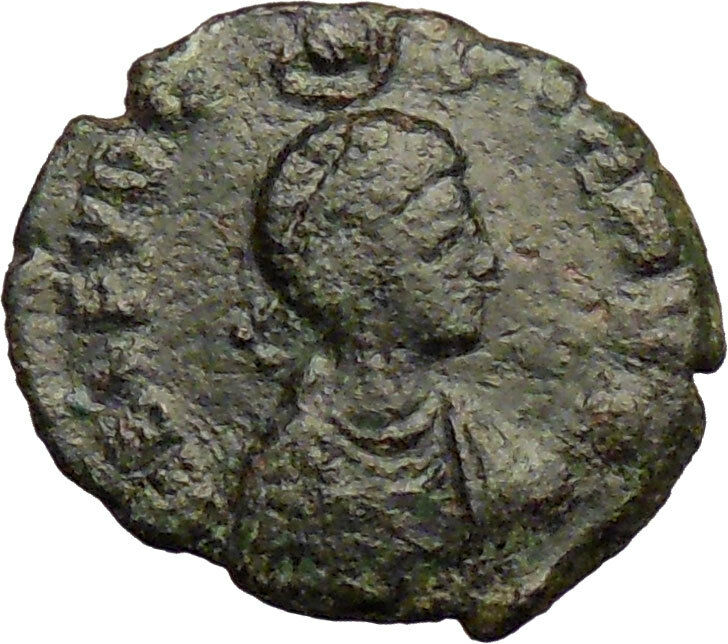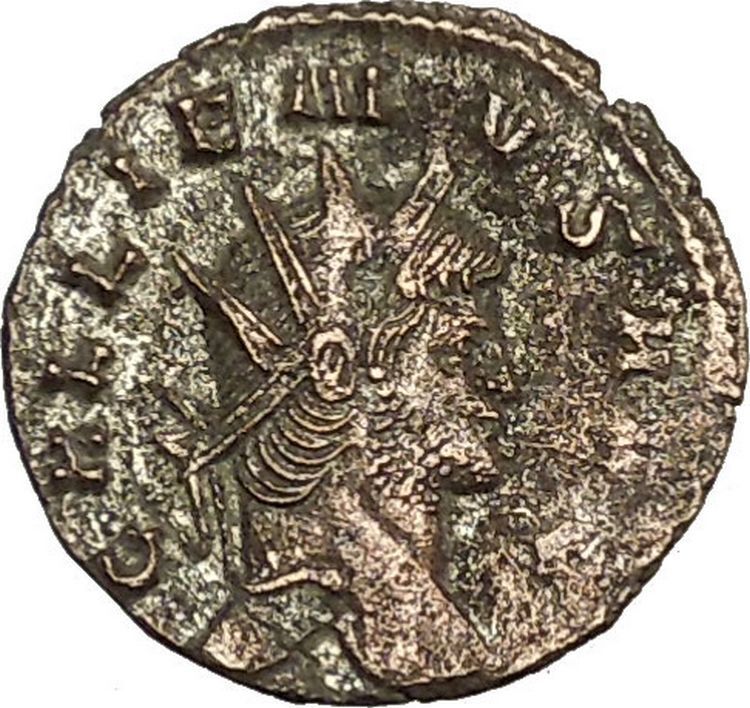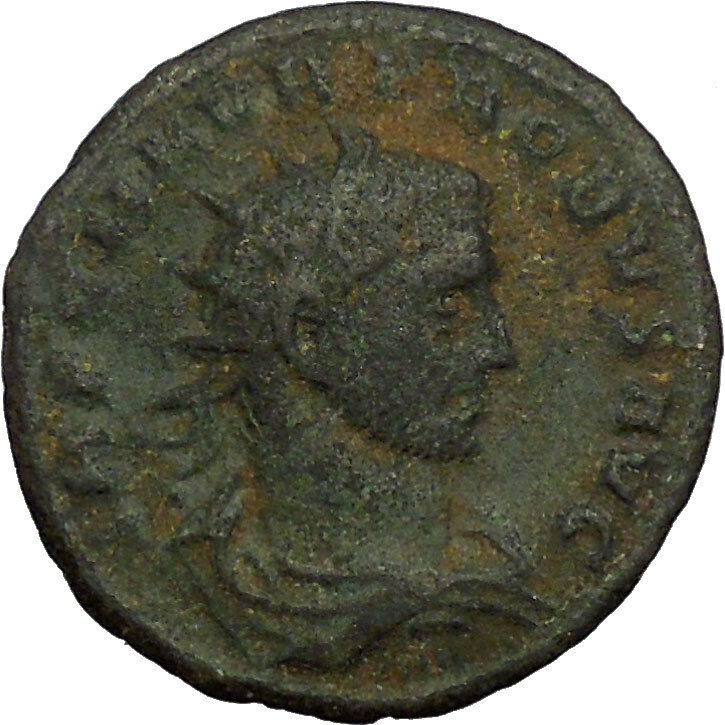|
Probus – Roman Emperor: 276-282 A.D.
Bronze Antoninianus 21mm (2.62 grams) Rome mint: 281 A.D.
Reference: RIC 187h, C 528
PROBVSPFAVG – Radiate bust left, wearing imperial mantle, holding scepter with eagle atop.
ROMAEAETER Exe: R Thunderbolt Δ – Temple with six columns; Roma seated within.
You are bidding on the exact item pictured, provided with a Certificate of Authenticity and Lifetime Guarantee of Authenticity.
The Temple of Venus and Roma Latin: Templum Veneris et Romae is thought to have been the largest temple in Ancient Rome. Located on the Velian Hill, between the eastern edge of the Forum Romanum and the Colosseum, it was dedicated to the goddesses Venus Felix (“Venus the Bringer of Good Fortune”) and Roma Aeterna (“Eternal Rome”). The architect was the emperor Hadrian and construction began in 121. It was officially inaugurated by Hadrian in 135, and finished in 141 under Antoninus Pius. Damaged by fire in 307, it was restored with alterations by the emperor Maxentius.

Temple of Venus and Roma seen from the Colosseum
History
In order to build the temple, erected on the remnants of the porticoed vestibule to Emperor Nero’s Domus Aurea, the Colossus of Nero was moved and placed near the amphitheatre, which shortly afterwards became known as the Colosseum. Unimpressed by his emperor’s architectural skills, Hadrian’s most brilliant architect, Apollodorus, made a scornful remark on the size of the seated statues within the cellae, saying that they would surely hurt their heads if they tried to stand up from their thrones. Apollodorus was banished and executed not long after this.
According to the ancient historian Ammianus Marcellinus the temple was among the great buildings of Rome which astonished the Emperor Constantius II on his visit to the city in 357.
Further restoration was performed under Eugenius, a short-lived usurper (392-394) against Theodosius I, whose policy was the restoration of Pagan cults and temples. However, as with many of Rome’s majestic ancient buildings the temple was later targeted for its rich materials. In 630 Pope Honorius I with the consent of the Emperor Heraclius, removed the gilt-bronze tiles from the roof of the temple for the adornment of St. Peter’s.
A severe earthquake at the beginning of the 9th century is believed to have destroyed the temple. Around 850 Pope Leo IV ordered the building of a new church, Santa Maria Nova, on the ruins of the temple. After a major rebuilding in 1612, this church was renamed Santa Francesca Romana, incorporating Roma’s cella as the belltower. A somewhat fanciful vedute engraving by Giovanni Battista Mercati depicts the site in 1629. The vast quantity of marble that once adorned the temple has all but disappeared due to its use as a raw material for building projects from the Middle Ages onwards. The Italian archaeologist Rodolfo Amedeo Lanciani makes reference to his discovery of a lime kiln in close proximity to the temple in his work The Destruction of Ancient Rome.
Presently only a few columns surrounding remain standing in their original positions, while others that have gone missing have been replaced by buxus trees.
Architecture
Set on a platform measuring 145 metres (476 ft) in length and 100 metres (330 ft) in width, and stood 29.5 metres (97 ft) tall, being 31 metres (102 ft) counting the statues, the peristyle (also peripteral) building measured 110 metres (360 ft) in length and 53 metres (174 ft) in width. The temple itself consisted of two main chambers (cellae), each housing a cult statue of a god-Venus, the goddess of love, and Roma, the goddess of Rome, both figures seated on a throne. The cellae were arranged symmetrically back-to-back. Roma’s cella faced west, looking out over the Forum Romanum, and Venus’ cella faced east, looking out over the Colosseum. A row of four columns (tetrastyle) lined the entrance to each cella, and the temple was bordered by colonnaded entrances ending in staircases that led down to the Colosseum.

The west and east sides of the temple (the short sides) had ten white columns (decastyle), and the south and north (the long sides) featured eighteen white columns. All of these columns measured 1.8 metres (5 ft 11 in) in width, making the temple very imposing.
A reconstruction of the temple interior by German Architect Josef Bühlmann from 1913 depicts two longitudinal colonnades of Corinthian columns forming a central nave flanked by two aisles below a coffered vaulted ceiling. Resting on the columns a double impost forms a double entablature extending back into the exedra, with a cofferred half-dome ceiling above the seated statue. The walls behind the aisles are inset with smaller columns standing some distance above the floor on a plinth. Small statues set in niches between these columns punctuate the walls, the niches surmounted by alternating arched and triangular pediments. More small statues are positioned on the entablature above each small column.
As an additional clever subtlety by Hadrian, Venus also represented love (Amor in Latin), and “AMOR” is “ROMA” spelled backwards. Thus, placing the two divinities of Venus and Rome back-to-back in a single temple created a further symmetry with the back-to-back symmetry of their names as well. Within Venus’ cella was another altar where newly wed couples could make sacrifices. Directly adjacent to this altar stood gigantic silver statues of Marcus Aurelius and Faustina the Younger.
Today
Since the papacy of John Paul II, the heights of the temple and its position opposite the main entrance to the Colosseum have been used to good effect as a public address platform. This may be seen in the photograph below where a red canopy has been erected to shelter the Pope as well as an illuminated cross, on the occasion of the Good Friday ceremony. The Pope, either personally or through a representative, leads the faithful through meditations on the stations of the cross while a cross is carried from there to the Colosseum.
The Temple has now been reopened to the public after an extensive restoration programme that lasted 26 years. Access to the temple is included in tickets for the Colosseum, the Forum and the Palatine Hill.

In ancient Roman religionn, Roma was a female deity who personified the city of Rome and more broadly, the Roman state. “As personification, as goddess or as symbol, the name Roma stretches from classical Greece to Mussolini’s Fascist propaganda… Roma has been seen as a goddess, a whore, a near-saint, and as the symbol of civilization itself. She remains the oldest continuous political-religious symbol in Western civilization.” Ronald Mellor, Introduction, The goddess Roma.
The earliest certain cult to dea Roma was established at Smyrna in 195 BCE, probably to mark Rome’s successful alliance against Antiochus III. Mellor has proposed her cult as a form of religio-political diplomacy which adjusted traditional Graeco-Eastern monarchic honours to Republican mores: honours addressed to the divine personification of the Roman state acknowledged the authority of its offices, Republic and city as divine and eternal.
Democratic city-states such as Athens and Rhodes accepted Roma as analogous to their traditional cult personifications of the demos (ordinary people). In 189 BCE, Delphi and Lycia instituted festivals in her honour. Roma as “divine sponsor” of athletics and pan-Hellenic culture seems to have dovetailed neatly into a well-established and enthusiastic festival circuit, and temples to her were outnumbered by her civic statues and dedications. In 133 BCE Attalus III bequeathed the people and territories of Pergamon to Rome, as to a trusted ally and protector. The Pergamene bequest became the new Roman province of Asia, and Roma’s cult spread rapidly within it.
In Hellenistic religious tradition, gods were served by priests and goddesses by priestesses but Roma’s priesthood was male, perhaps in acknowledgment of the virility of Rome’s military power. Priesthood of the Roma cult was competed among the highest ranking local elites. In contrast to her putative “Amazonian” Roman original, Greek coinage depicts Roma in the “dignified and rather severe style” of a Greek goddess, often wearing a mural crown, or sometimes a Phrygian helmet. She is occasionally bareheaded. In this and later periods, she was often associated with Zeus (as guardian of oaths) and Fides (the personification of mutual trust). Her Eastern cult appealed for Rome’s loyalty and protection – there is no reason to suppose this as other than genuine (and diplomatically sound) respect. A panegyric to her survives, in five Sapphic stanzas attributed to Melinno. In Republican Rome and its Eastern colonae her cult was virtually non-existent.
Roma was thus absorbed into the earliest (Eastern) form of “Imperial cult” – or, from an Eastern viewpoint, the cult to Augustus was grafted onto their time-honoured cult to Roma. From here on, she increasingly took the attributes of an Imperial or divine consort to the Imperial divus, but some Greek coin types show her as a seated or enthroned authority, and the Imperial divus standing upright as her supplicant or servant.The Imperial cult arose as a pragmatic and ingenious response to an Eastern initiative. It blended and “renewed” ancient elements of traditional religions and Republican government to create a common cultural framework for the unification of Empire as a Principate. In the West, this was a novelty, as the Gauls, Germans and Celts had no native precedent for ruler cult or a Roman-style administration.
The foundation of the Imperial cult centre at Lugdunum introduced Roman models for provincial and municipal assemblies and government, a Romanised lifestyle, and an opportunity for local elites to enjoy the advantages of citizenship through election to Imperial cult priesthood, with an ara (altar) was dedicated to Roma and Augustus. Thereafter, Roma is well attested by inscriptions and coinage throughout the Western provinces. Literary sources have little to say about her, but this may reflect her ubiquity rather than neglect: in the early Augustan era, she may have been honoured above her living Imperial consort.
In the city of Rome itself, the earliest known state cult to dea Roma was combined with cult to Venus at the Hadrianic Temple of Venus and Roma. This was the largest temple in the city, probably dedicated to inaugurate the reformed festival of Parilia, which was known thereafter as the Romaea after the Eastern festival in Roma’s honour. The temple contained the seated, Hellenised image of dea Roma – the Palladium in her right hand symbolised Rome’s eternity. In Rome, this was a novel realisation. Greek interpretations of Roma as a dignified deity had transformed her from a symbol of military dominance to one of Imperial protection and gravitas.
 Probus (Latin: Marcus Aurelius Probus Augustus; c. 19 August 232 – September/October 282), was Roman Emperor from 276 to 282. Probus (Latin: Marcus Aurelius Probus Augustus; c. 19 August 232 – September/October 282), was Roman Emperor from 276 to 282.
During his reign, the Rhine and Danube frontier was strengthened after successful wars against several Germanic tribes such as the Goths, Alamanni, Longiones, Franks, Burgundians, and Vandals. The Agri Decumates and much of the Limes Germanicus in Germania Superior were officially abandoned during his reign, with the Romans withdrawing to the Rhine and Danube rivers.
Early life
Born in 232 in Sirmium (modern day Sremska Mitrovica), Pannonia Inferior, the son of Dalmatius.
Military career
Probus entered the army around 250 upon reaching adulthood. Appointed as a military tribune by the emperor Valerian, he later distinguished himself under the emperors Aurelian and Tacitus. He was appointed governor of the East by Tacitus, whose death in 276 prompted Probus’ soldiers to proclaim him emperor.
Florianus, the half-brother of Tacitus, was also proclaimed successor by his soldiers, but he was killed after an indecisive campaign. Probus travelled west, defeating the Goths along the lower Danube in 277, and acquiring the title of Gothicus. His position as emperor was ratified by the Senate around this time.
As emperor

Sculpted head of Probus from Brescia in northern Italy.
In 278, Probus campaigned successfully in Gaul against the Alamanni and Longiones; both tribes had advanced through the Neckar valley and across the Rhine into Roman territory. Meanwhile, his generals defeated the Franks and these operations were directed to clearing Gaul of Germanic invaders (Franks and Burgundians), allowing Probus to adopt the titles of Gothicus Maximus and Germanicus Maximus.
One of his principles was never to allow the soldiers to be idle, and to employ them in time of peace on useful works, such as the planting of vineyards in Gaul, Pannonia and other districts, in order to restart the economy in these devastated lands. Of a greater and more lasting significance, Probus began the strategy of settling the Germanic tribes in the devastated provinces of the empire.
In 279-280, Probus was, according to Zosimus, in Raetia, Illyricum and Lycia, where he fought the Vandals. In the same years, Probus’ generals defeated the Blemmyes in Egypt. Probus then ordered the reconstruction of bridges and canals along the Nile, where the production of grain for the Empire was centered.
In 280-281, Probus put down three usurpers, Julius Saturninus, Proculus and Bonosus. The extent of these revolts is not clear, but there are clues that they were not just local problems (an inscription with the name of Probus erased has been found as far as Spain). In 281, the emperor was in Rome, where he celebrated his triumph.
Probus was eager to start his eastern campaign, delayed by the revolts in the west. He left Rome in 282, travelling first towards Sirmium, his birth city.
Assassination
Different accounts of Probus’s death exist. According to Joannes Zonaras, the commander of the Praetorian Guard Marcus Aurelius Carus had been proclaimed, more or less unwillingly, emperor by his troops.
Probus sent some troops against the new usurper, but when those troops changed sides and supported Carus, Probus’ remaining soldiers assassinated him at Sirmium (September/October 282). According to other sources, however, Probus was killed by disgruntled soldiers, who rebelled against his orders to be employed for civic purposes, like draining marshes. Carus was proclaimed emperor after Probus’ death and avenged the murder of his predecessor.
|








 Probus (Latin: Marcus Aurelius Probus Augustus; c. 19 August 232 – September/October 282), was Roman Emperor from 276 to 282.
Probus (Latin: Marcus Aurelius Probus Augustus; c. 19 August 232 – September/October 282), was Roman Emperor from 276 to 282.





